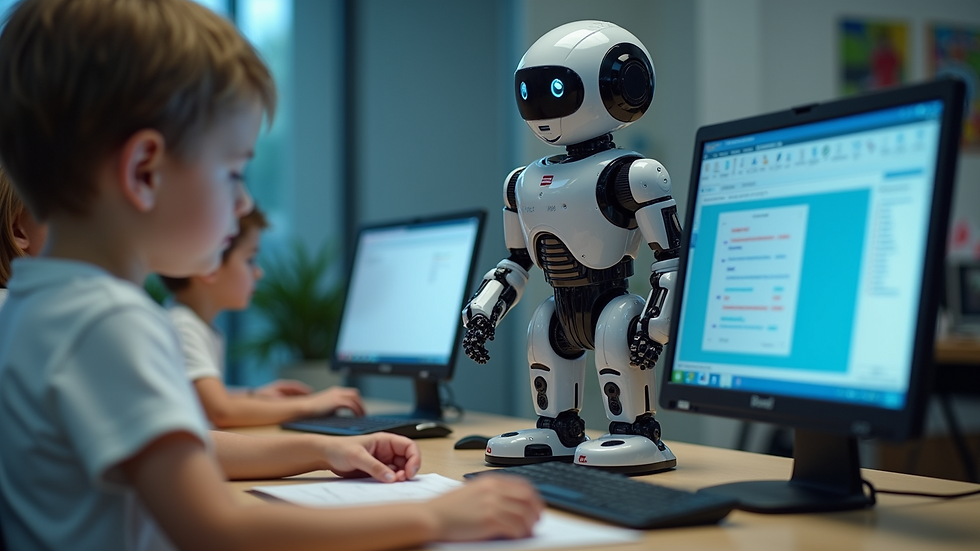Innovative STEM Robotics Program for Elementary to Middle School
- Franklin Qi
- Jul 26
- 4 min read
In today's fast-paced world, technology is everywhere. From smartphones to smart homes, understanding how these devices work is essential. One of the best ways to introduce young minds to technology is through robotics. An innovative STEM robotics program can spark interest in science, technology, engineering, and mathematics among elementary to middle school students.
This blog post will explore the benefits of such programs, the components that make them effective, and how they can be implemented in schools.
The Importance of STEM Education
STEM education is crucial for preparing students for the future. It encourages critical thinking, creativity, and problem-solving skills.
Critical Thinking: Students learn to analyze problems and come up with solutions.
Creativity: Robotics allows students to design and build their own projects.
Problem-Solving: Students face challenges that require them to think outside the box.
By integrating robotics into the curriculum, schools can make learning more engaging and relevant.
What is a Robotics Program?
A robotics program is an educational initiative that teaches students how to design, build, and program robots. These programs can vary in complexity, from simple kits for younger students to advanced projects for older students.
Key Components of a Robotics Program
Hands-On Learning: Students get to work with physical materials. This tactile experience enhances understanding.
Team Collaboration: Robotics projects often require teamwork. Students learn to communicate and collaborate effectively.
Coding Skills: Programming is a vital part of robotics. Students learn to write code that controls their robots.
Real-World Applications: Robotics connects classroom learning to real-world problems. Students see how their skills can be applied outside of school.
Mentorship Opportunities: Experienced mentors can guide students through complex projects. This support can inspire students to pursue careers in STEM fields.
Benefits of Robotics Programs
Robotics programs offer numerous benefits for students. Here are some of the most significant advantages:
Enhanced Engagement
Robotics is inherently fun. Students are more likely to engage with the material when they are building and programming robots.
Development of Soft Skills
In addition to technical skills, students develop soft skills such as teamwork, communication, and leadership. These skills are essential for success in any career.
Increased Confidence
Completing a robotics project can boost a student's confidence. They learn that they can tackle complex problems and succeed.
Exposure to STEM Careers
Robotics programs can introduce students to various STEM careers. They may discover interests they did not know they had.
Implementing a Robotics Program
Starting a robotics program in a school can seem daunting. However, with careful planning, it can be a rewarding experience. Here are some steps to consider:
Assessing Needs and Resources
Before starting a program, assess the needs of the students and the resources available.
Student Interest: Survey students to gauge their interest in robotics.
Available Resources: Determine what materials and equipment are available.
Choosing the Right Curriculum
Select a curriculum that aligns with the students' age and skill levels. There are many robotics kits and programs available, such as LEGO Mindstorms, VEX Robotics, and Arduino.
Training Educators
Teachers should receive training on how to implement the program effectively. Professional development workshops can help educators feel more confident in teaching robotics.
Creating a Supportive Environment
Encourage a culture of experimentation and learning from failure. Students should feel safe to take risks and try new ideas.
Engaging the Community
Involve parents and local businesses in the program. Community support can provide additional resources and mentorship opportunities.
Examples of Successful Robotics Programs
Many schools have successfully implemented robotics programs. Here are a few examples:
FIRST LEGO League
This program is designed for students aged 9 to 14. Teams build and program robots using LEGO bricks. They also work on a project related to a real-world problem.
VEX Robotics
VEX offers a range of robotics kits for different age groups. Students can participate in competitions, which adds an exciting element to the learning process.
After-School Robotics Clubs
Many schools have after-school clubs focused on robotics. These clubs provide students with additional time to explore their interests and work on projects.
Challenges and Solutions
While robotics programs are beneficial, they can also face challenges. Here are some common issues and potential solutions:
Funding
Challenge: Robotics kits and materials can be expensive.
Solution: Seek grants, sponsorships, or community donations to fund the program.
Time Constraints
Challenge: Teachers may struggle to find time in the curriculum for robotics.
Solution: Integrate robotics into existing subjects, such as math or science.
Skill Levels
Challenge: Students may have varying skill levels.
Solution: Offer differentiated instruction to meet the needs of all students.
The Future of Robotics in Education
As technology continues to evolve, the role of robotics in education will likely expand. Schools will need to adapt their programs to keep pace with advancements in technology.
Embracing New Technologies
Educators should stay informed about new tools and technologies in robotics. This knowledge will help them provide the best learning experiences for their students.
Fostering Lifelong Learning
Robotics programs can instill a love for learning in students. They will be more likely to pursue further education and careers in STEM fields.
Building a Stronger Workforce
By preparing students for the future, robotics programs contribute to a stronger workforce. Students will be equipped with the skills needed for the jobs of tomorrow.
Inspiring the Next Generation
In conclusion, an innovative STEM robotics program can transform the educational experience for elementary to middle school students. By engaging them in hands-on learning, fostering collaboration, and developing essential skills, these programs can inspire the next generation of innovators and problem solvers.
As we look to the future, it is crucial to invest in these programs. They not only prepare students for careers in STEM but also help them become well-rounded individuals.
Let us embrace the power of robotics in education and watch as our students thrive.



Comentários